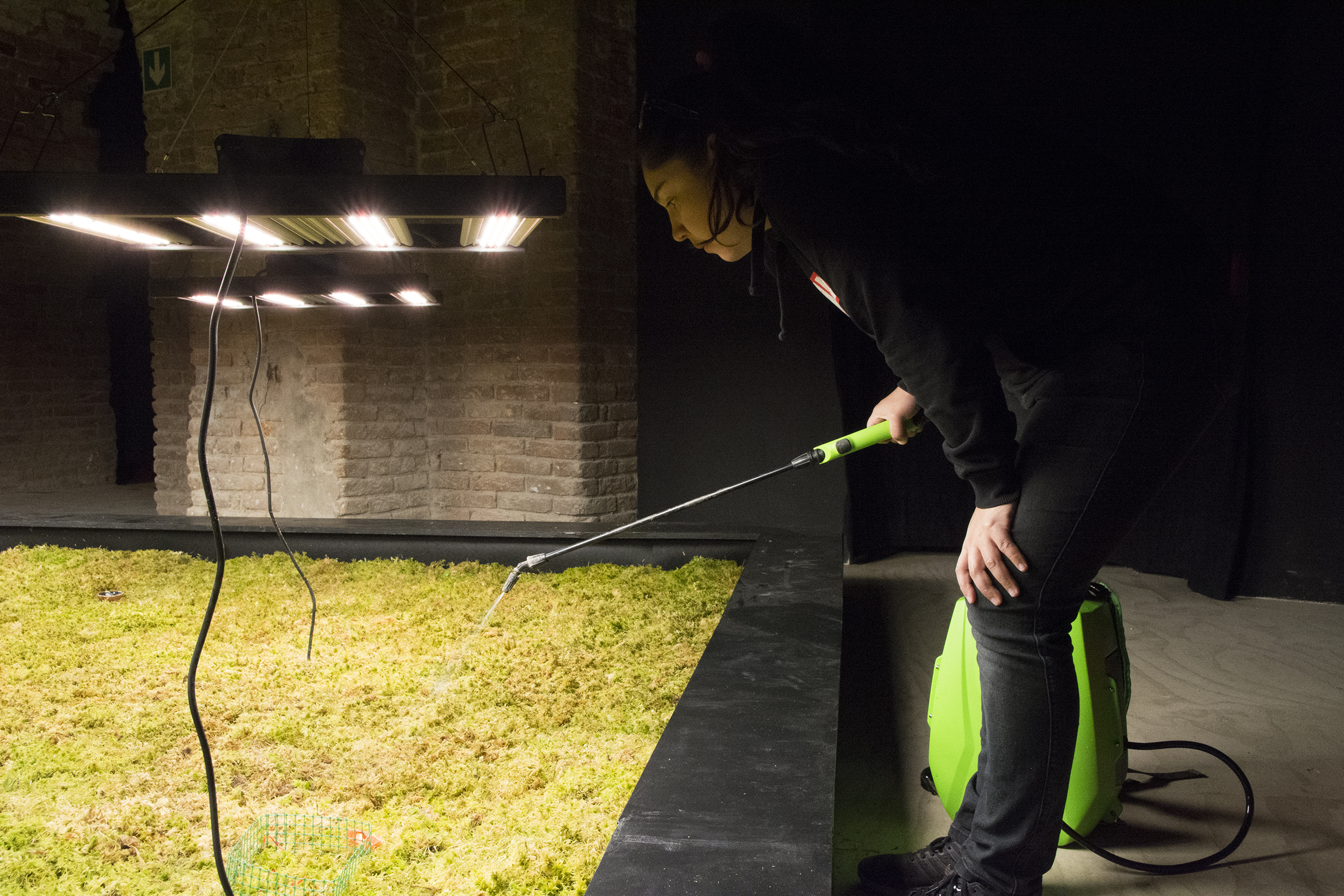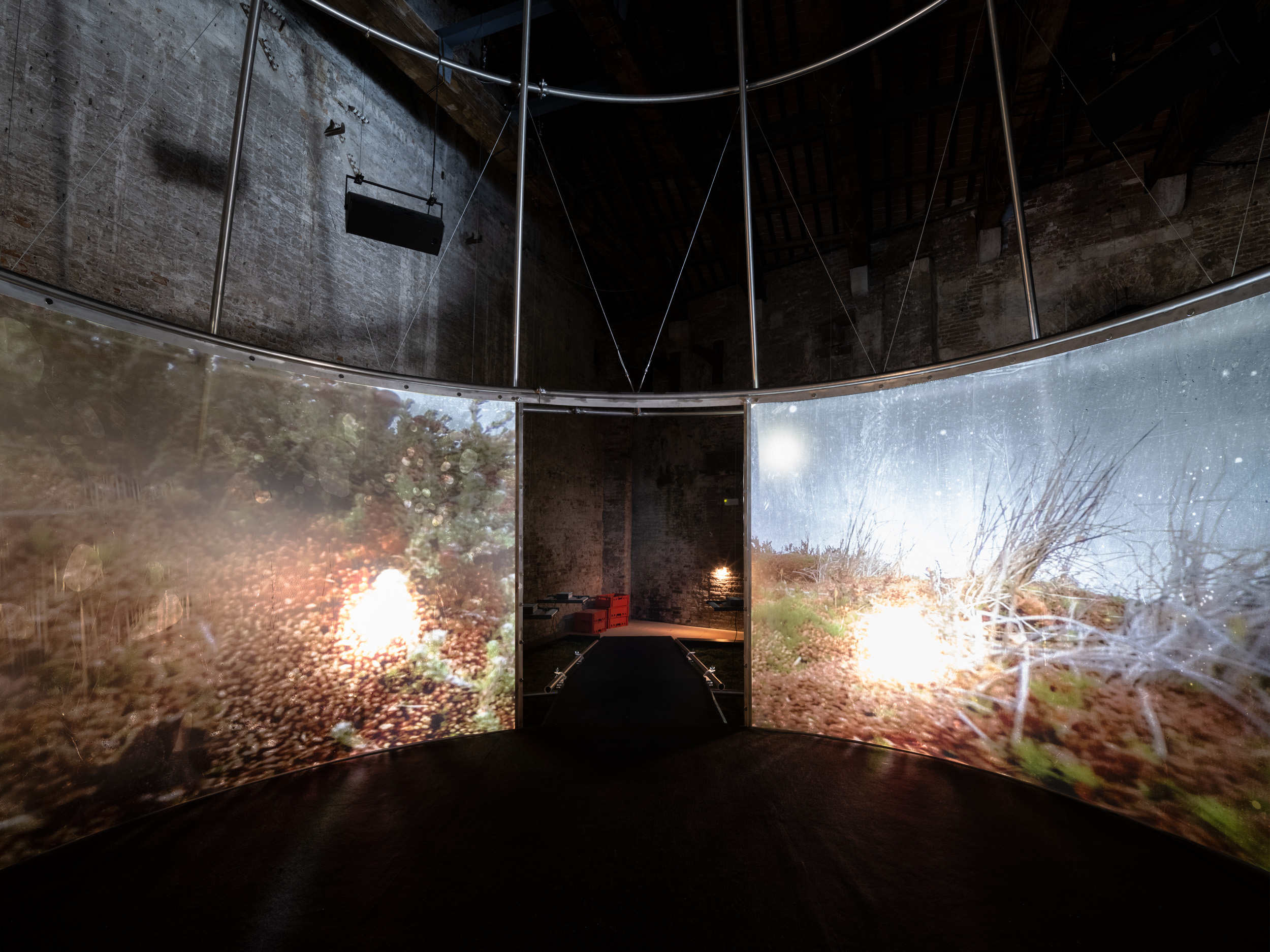In Tierra del Fuego, in Chilean Patagonia, lies Karukinka, a remote southern park, four times the size of greater Santiago, which was donated to the Wildlife Conservation Society (WCS) for conservation and is managed by WCS Chile. This natural laboratory of almost 300,000 hectares seeks to conserve the natural environment, educate and generate knowledge and awareness about the relevance of biodiversity for natural, social, cultural and economic development. Peatlands, ecosystems that house rich biodiversity including insects, microorganisms, fishes and lichens, cover over a quarter of the park. It was these peatlands that inspired visual artist Camila Marambio to dedicate her career to working for their conservation, after a trip to Karukinka and conversations with Bárbara Saavedra, director of WCS Chile.
Since that first meeting in 2009, and inspired by powerful experiences lived by the artist, various initiatives have emerged which now converge in the pavilion currently representing Chile at the 59th International Exhibition of the Venice Biennale, which features Chile’s Patagonian peat bogs as its central axis.

Fotografía de Daniela Aravena
When the public competition to apply for the Biennale opened, Bárbara said, ‘let's do it!’. I would never have applied if it hadn't been to highlight this urgent need to protect an ecosystem and to give it roots, knowing that there is local work, that Venice is not the last stop for this project. Our next step relates to the Patagonian Peatlands Initiative, and the idea is that this will place us within the global peatland protection initiatives and allow us to continue forging this path through an array of global alliances which are not only scientific, but can also be artistic," said Camila Marambio, regarding her motivation for applying for the Chilean pavilion.
This is how Turba Tol Hol-Hol Tol arises from the research of the Ensayos collective, in collaboration with WCS Chile, Karukinka Park in Tierra del Fuego and the Selk'nam Hach Saye Cultural Foundation. The collective project, led by curator Camila Marambio, proposes an experimental path towards conservation, promoting the research and visibility of peatlands, the most efficient terrestrial ecosystem in accumulating carbon and yet one of the least researched.
For Bárbara Saavedra, "knowledge is something that happens in many places. Initially, the incorporation of science outside its own spaces was between disciplines, but today this has been overcome and what we need is to position the sciences within the societies in which they operate, getting in touch with the problems and also finding, in a collaborative way, the solutions to these complex things. The arts may seem to be a very different world to the sciences, but in reality they are not – from the point of view of creativity, questioning, innovation, they are very similar. Therefore, the possibility of meeting with each other opens up enormous spaces yet to be explored for the development of new things, new perspectives and new tools to promote conservation and Turbatol is one of them".
"Hol-Hol Tol" means “the heart of the peat bogs” in the language of the Selk'nam people, one of the original inhabitants of Tierra del Fuego, and the exhibition offers an immersion into the material and ancestral experience of the peat bogs with a multi-sensorial installation, highlighting an aesthetic of care and art as a conductor of real commitments to advance on the path of ecological action. Turba Tol Hol-Hol Tol brings together a multidisciplinary team of Chilean creatives: sound artist Ariel Bustamante, art historian Carla Macchiavello, filmmaker Dominga Sotomayor and architect Alfredo Thiermann. These artists are joined as co-authors of the project by Bárbara Saavedra, ecologist and director of WCS Chile; Selk'nam writer Hema'ny Molina and cultural producer Juan Pablo Vergara, among many others: Rosario Ureta (design), Mateo Zlatar (web design), Carola del Río (web development), Freja Carmichael, Caitlin Franzmann, Christy Gast, Randi Nygård, Renee Rossini, Karolin Tampere, Agustine Zegers, Simon Daniel Tegnander Wenzel (smell), Sebastián Cruz (museography), Nicolás Arze and Christy Gast (art direction), Benjamín Echazarreta (direction of photography), Isabel Torres (voice over), Constanza Güell (catalogue), Fernanda Olivares (Selk'nam guide), Nicole Püschel (climate change and biodiversity), Antonia Peón-Veiga (lighting), Susanne Abel, Matthias Krebs, Jan Peters (Sphagnum Lab) and Alessandra Dal Mos (production Italy).
Dianna Kopansky, Global Peatlands Coordinator at UNEP, commented: “Turba Hol-Hol Tol is such a valuable addition to the work going on to protect, restore and sustainably manage peatlands around the world. We know well peatlands’ value for the climate, for biodiversity and the many ecosystem services they offer. Turba Hol-Hol Tol highlights their intangible value – their ability to connect, inspire and mobilise people, and their incalculable human and cultural value. I look forward to experiencing the installation in person when I visit the Biennale for workshops ahead of the signing of the Venice Agreement.”

Fotografía de Ugo Carmeni
This release is part of the Global Peat Press Project (GP3) campaign, bringing together international partners to highlight the importance of peatlands as vulnerable but valuable ecosystems. It is a coordinated media outreach from the UNEP’s Global Peatlands Initiative (GPI) and the North Pennines AONB Partnership to promote the UN Decade on Ecosystem Restoration (2021-2030). It was conceived to raise awareness and enthusiasm about the role of peatlands in climate action in the run-up to the UNFCCC COP26 in November, and has now pivoted to focus on the vital importance of peatlands for nature, aiming to build momentum and interest in advance of the Convention on Biological Diversity (CBD) COP15 in April next year. A relay of stories from peatland projects worldwide, GP3 started with the UK, as the host of COP26, which took place in Glasgow, Scotland.
The relay has already featured:
- the North Pennines AONB
- the Care-Peat project in Belgium
- NUI Galway/ Insight Centre
- Five EU transnational projects (Carbon Connects, Care-Peat, DESIRE, LIFE Peat Restore, and
- CANAPE)
- Bax & Company who straddle the UK, Spain and The Netherlands
- Ulster Wildlife
- The Lancashire Wildlife Trust
- The GPI and EUROSITE Peatlands Social Media Campaign
- NABU
- Moors for the Future Partnership
- Metsähallitus with its Hydrology LIFE Project
- Natural Resources Wales with the LIFE Welsh Raised Bogs Project
- Community Wetlands Forum and the Landscape Finance Lab
- Terra Motion
- Green Restoration Ireland Coop (GRI)
- a major restoration effort in Belarus recognized by the Ministry of Natural Resources and
- Environmental Protection of the Republic of Belarus
- a second release from Ulster Wildlife
- The World Conservation Monitoring Centre (WCMC) at the UN
- Griefswald Mire Centre in Germany
- Conservatoires d’éspaces naturels in France
- the Cairngorms National Park, Scotland
- a second contribution from the North Pennines AONB
- CINEA – LIFE
- Baltic Environmental Forum Lithuania
- Yorkshire Peat Partnership
- APB-BirdLife Belarus
- Frankfurt Zoological Society
- Tompkins Conservation and Rewilding Argentina
- Wetlands International
- Moors for the Future Partnership
- The Ramsar Convention on Wetlands of International Importance Especially as Waterfowl Habitat
- Wildlife Conservation Society Canada
- Wildlife Conservation Society Peru
- WaterLANDS
And now the baton is held by WCS Chile.
Join us – share, learn, inspire, experience and act for peatlands, people and the planet. Follow and
share using #PeatlandsMatter and #GenerationRestoration.
END
Notes to the Editor:
About WCS Chile:
WCS saves wild lives and landscapes across the whole world through science, conservation and education actions, and inspiring human beings to value nature. WCS imagines a world where wildlife thrives on healthy lands and in healthy seas, valued by societies which adopt and benefit from the diversity and integrity of life on Earth. Karukinka Park is a natural classroom and laboratory for conservation, where we inspire people to value and care for biodiversity through science, education and public use. Karukinka Park safeguards and promotes the terrestrial and coastal conservation and biodiversity of Tierra del Fuego and is valued for its contribution to the wellbeing of current and future generations.
About Turba Hol-Hol Tol:
The Turba Tol Hol-Hol Tol Pavilion is a collective project led by curator Camila Marambio that proposes an experimental path towards the conservation and visibility of peatlands. Presented by the Ministry of Cultures, Arts and Heritage and the Ministry of Foreign Affairs of the Government of Chile at the 59th International Exhibition, La Biennale di Venezia, which had its official opening on the 23rd of April. It is a collaborative work between art, science and traditional knowledge, promoting research and ecological transition from the environmental humanities.
About Ensayos:
Ensayos is a collective research practice centred on de-extinction, multispecies dialogues, coastal health and peatland protection. Initiated on the archipelago of Tierra del Fuego in 2010, Ensayos (meaning “inquiries”, “essays” or “rehearsals” in English) first focused solely on the ecopolitical issues impacting the Fuegian archipelago and its inhabitants–past and present, human and nonhuman. Now, other archipelagos have come into view, with research “pods” growing in Norway, New York and Australia. The mission of Ensayos is to do eco-cultural conservation work in Tierra del Fuego and other archipelagos through collaborative art, science and community projects in partnership with existing ecological and cultural conservation initiatives. On the main isle of Tierra del Fuego, WCS Parque Karukinka, Caleta María, and Hach Saye are foundational collaborators.
About the Global Peatlands Initiative (GPI):
The Global Peatlands Initiative is an international partnership launched at the UNFCCC COP in Marrakech, Morocco, in late 2016. Led by the United Nations Environment Programme (UNEP), our goal is to protect and conserve peatlands as the world’s largest terrestrial organic carbon stock and to prevent it being emitted into the atmosphere.